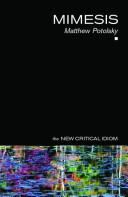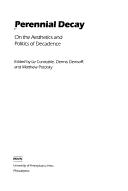| Listing 1 - 7 of 7 |
Sort by
|

ISBN: 0415700302 9780415700306 0415700299 9780415700290 020340100X 9780203401002 9781135996000 9781135996048 9781135996055 Year: 2006 Publisher: New York, N.Y. Routledge
Abstract | Keywords | Export | Availability | Bookmark
 Loading...
Loading...Choose an application
- Reference Manager
- EndNote
- RefWorks (Direct export to RefWorks)
A topic that has become increasingly central to the study of art, performance and literature, the term mimesis has long been used to refer to the relationship between an image and its 'real' original. However, recent theorists have extended the concept, highlighting new perspectives on key concerns, such as the nature of identity. Matt Potolsky presents a clear introduction to this potentially daunting concept, examining: * the foundations of mimetic theory in ancient philosophy, from Plato to Aristotle * three key versions of mimesis: imitatio or rhetorical imitation, theatre and theatricality, and artistic realism * the position of mimesis in modern theories of identity and culture, through theorists such as Freud, Lacan, Girard and Baudrillard * the possible future of mimetic theory in the concept of 'memes', which connects evolutionary biology and theories of cultural reproduction. A multidisciplinary study of a term rapidly returning to the forefront of contemporary theory, Mimesis is a welcome guide for readers in such fields as literature, performance and cultural studies.
82:003 --- #KVHA:Retoriek --- #KVHA:Imitatie --- Semiotiek in de literatuur --- Mimesis in literature. --- 82:003 Semiotiek in de literatuur --- Mimesis in literature --- Representation (Literature) --- Imitation in literature --- Realism in literature --- Literary semiotics --- Literary rhetorics --- Représentation (littérature)
Book
ISBN: 1283898608 0812207335 0812244494 Year: 2013 Publisher: Philadelphia : University of Pennsylvania Press,
Abstract | Keywords | Export | Availability | Bookmark
 Loading...
Loading...Choose an application
- Reference Manager
- EndNote
- RefWorks (Direct export to RefWorks)
While scholars have long associated the group of nineteenth-century French and English writers and artists known as the decadents with alienation, escapism, and withdrawal from the social and political world, Matthew Potolsky offers an alternative reading of the movement. In The Decadent Republic of Letters, he treats the decadents as fundamentally international, defined by a radically cosmopolitan ideal of literary sociability rather than an inward turn toward private aesthetics and exotic sensation.The Decadent Republic of Letters looks at the way Charles Baudelaire, Théophile Gautier, and Algernon Charles Swinburne used the language of classical republican political theory to define beauty as a form of civic virtue. The libertines, an international underground united by subversive erudition, gave decadents a model of countercultural affiliation and a vocabulary for criticizing national canon formation and the increasing state control of education. Decadent figures such as Joris-Karl Huysmans, Walter Pater, Vernon Lee, Aubrey Beardsley, and Oscar Wilde envisioned communities formed through the circulation of art. Decadents lavishly praised their counterparts from other traditions, translated and imitated their works, and imagined the possibility of new associations forged through shared tastes and texts. Defined by artistic values rather than language, geography, or ethnic identity, these groups anticipated forms of attachment that are now familiar in youth countercultures and on social networking sites.Bold and sophisticated, The Decadent Republic of Letters unearths a pervasive decadent critique of nineteenth-century notions of political community and reveals the collective effort by the major figures of the movement to find alternatives to liberalism and nationalism.
Decadence (Literary movement) --- English literature --- French literature --- Literature and society --- Literary movements --- Literature, Modern --- History and criticism. --- History --- History and criticism --- Cultural Studies. --- Literature.
Book
ISBN: 9780812244496 Year: 2013 Publisher: Philadelphia : University of Pennsylvania Press,
Abstract | Keywords | Export | Availability | Bookmark
 Loading...
Loading...Choose an application
- Reference Manager
- EndNote
- RefWorks (Direct export to RefWorks)
While scholars have long associated the group of nineteenth-century French and English writers and artists known as the decadents with alienation, escapism, and withdrawal from the social and political world, Matthew Potolsky offers an alternative reading of the movement. InThe Decadent Republic of Letters, he treats the decadents as fundamentally international, defined by a radically cosmopolitan ideal of literary sociability rather than an inward turn toward private aesthetics and exotic sensation.The Decadent Republic of Letterslooks at the way Charles Baudelaire, Théophile Gautier, and Algernon Charles Swinburne used the language of classical republican political theory to define beauty as a form of civic virtue. The libertines, an international underground united by subversive erudition, gave decadents a model of countercultural affiliation and a vocabulary for criticizing national canon formation and the increasing state control of education. Decadent figures such as Joris-Karl Huysmans, Walter Pater, Vernon Lee, Aubrey Beardsley, and Oscar Wilde envisioned communities formed through the circulation of art. Decadents lavishly praised their counterparts from other traditions, translated and imitated their works, and imagined the possibility of new associations forged through shared tastes and texts. Defined by artistic values rather than language, geography, or ethnic identity, these groups anticipated forms of attachment that are now familiar in youth countercultures and on social networking sites. Bold and sophisticated,The Decadent Republic of Lettersunearths a pervasive decadent critique of nineteenth-century notions of political community and reveals the collective effort by the major figures of the movement to find alternatives to liberalism and nationalism
Decadence (Literary movement) --- English literature --- French literature --- Literature and society --- History and criticism. --- History
Book
ISBN: 9780812207330 Year: 2012 Publisher: Philadelphia
Abstract | Keywords | Export | Availability | Bookmark
 Loading...
Loading...Choose an application
- Reference Manager
- EndNote
- RefWorks (Direct export to RefWorks)

ISBN: 0812216784 1336206055 0812292480 9780812216783 0812234707 Year: 2015 Publisher: Philadelphia : University of Pennsylvania Press,
Abstract | Keywords | Export | Availability | Bookmark
 Loading...
Loading...Choose an application
- Reference Manager
- EndNote
- RefWorks (Direct export to RefWorks)
When Oscar Wilde was convicted of gross indecency in 1895, a reporter for the National Observer wrote that there was "not a man or a woman in the English-speaking world possessed of the treasure of a wholesome mind who is not under a deep debt of gratitude to the marquis of Queensberry for destroying the high Priest of the Decadents." But reports of the death of decadence were greatly exaggerated, and today, more than one hundred years after the famous trial and at the beginning of a new millennium, the phenomenon of decadence continues to be a significant cultural force.Indeed, "decadence" in the nineteenth century, and in our own period, has been a concept whose analysis yields a broad set of associations. In Perennial Decay, Emily Apter, Charles Bernheimer, Sylvia Molloy, Michael Riffaterre, Barbara Spackman, Marc Weiner, and others extend the critical field of decadence beyond the traditional themes of morbidity, the cult of artificiality, exoticism, and sexual nonconformism. They approach the question of decadence afresh, reevaluating the continuing importance of late nineteenth-century decadence for contemporary literary and cultural studies.
Decadence in art --- Decadentie in de kunst --- Décadence dans l'art --- Decadence in art. --- Decadence (Literary movement). --- Aesthetics, Modern --- Arts, Modern --- Decadence (Literary movement) --- Arts [Modern ] --- 19th century --- Aesthetics [Modern ] --- 20th century --- Literary movements --- Literature, Modern --- Aesthetics --- History and criticism --- History
Book
ISBN: 9780812292480 Year: 2015 Publisher: Philadelphia
Abstract | Keywords | Export | Availability | Bookmark
 Loading...
Loading...Choose an application
- Reference Manager
- EndNote
- RefWorks (Direct export to RefWorks)
Book
ISBN: 9780198823438 0198823436 9780198816164 0198816162 9780198861928 Year: 2019 Publisher: Oxford : Oxford University Press,
Abstract | Keywords | Export | Availability | Bookmark
 Loading...
Loading...Choose an application
- Reference Manager
- EndNote
- RefWorks (Direct export to RefWorks)
Pater, Walter, --- Pater, Walter, --- Pater, Walter, --- Criticism and interpretation.
| Listing 1 - 7 of 7 |
Sort by
|

 Search
Search Feedback
Feedback About UniCat
About UniCat  Help
Help News
News